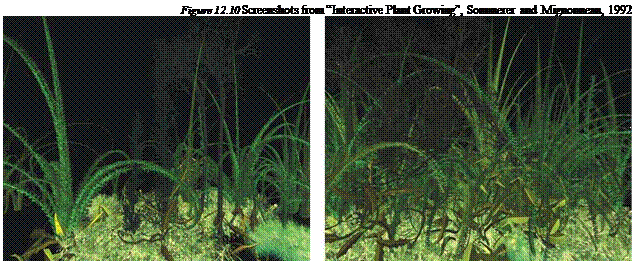This work originated in 1992/93 as the first joint work of the two artists. It was shown world-wide and also was part of the permanent exhibition of the ZKM Media Museum in Karlsruhe. The viewer enters a dark area of 6×7.5 meters, into which five platforms with five different plants face a 4×3 meters-large projection in a semicircle. If the visitor comes close to a plant or touches it, then different virtual plants grow in the projection. Each real plant is assigned a type of a virtual plant. With each interaction the screen fills more and more, and one ends with a jungle of ferns, grasses and mosses. Using a cactus that functions as an eraser, the viewer can wipe the screen again. Several visitors can thus generate a virtual garden together at the same time.
“Interactive Plant Growing” was an early example of the use of a natural interface that took the term naturalness literally, and for the first time used a living organism as an interface in an interactive installation. With the help of algorithms and random parameters, it was Sommerer and Mignonneau’s first attempt to generate interactively in real time the highest visual variance possible. This work served as the starting point for their later evolutionary work. The software knows five algorithms for plant species, which can be varied randomly using reduced parameter ranges.

For each plant there are at least six such variation descriptions. For example, stem length, branching angle, stem curvature, and color of branched structures are changed across these variation descriptions. The values, which are selected from this denotation, can be changed interactively by the viewer, while the plant slowly grows.
A sensor attached to the roots of the real plant measures the electrical potential difference between the plant and the viewer, which depends on the distance to the viewer, its physical characteristics, the humidity of the soil in the pot, and other parameters. This potential difference is measurable up to a distance of
70 cm from the plant. At the beginning of the interaction, the location, the rotation, the type of the plant, and the variation description are specified. This is what Sommerer and Mignonneau compare with the determination in biology: the definition of an expression in the phylogenesis of the art. The differentiation, the expression of the characteristics of the individual, depends on the continuously changing potential difference indicated by the viewer. “Interactive Plant Growing” has been implemented on different computers. The work was developed on a Silicon Graphics VGX 320 and now runs on Silicon Graphics computers, as well as on PCs.



